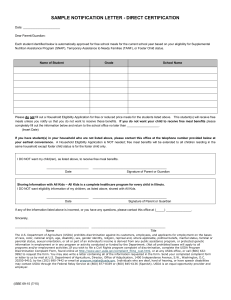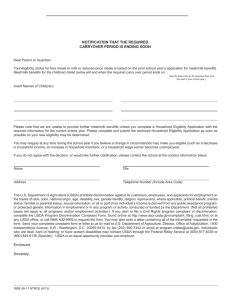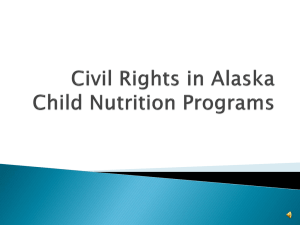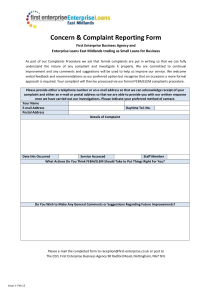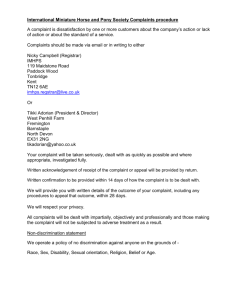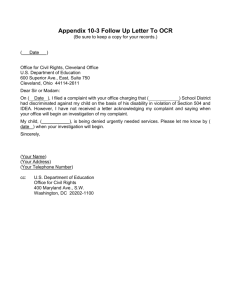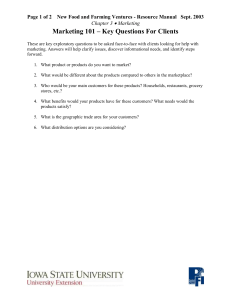Title VI – Civil Rights Act of 1964
advertisement
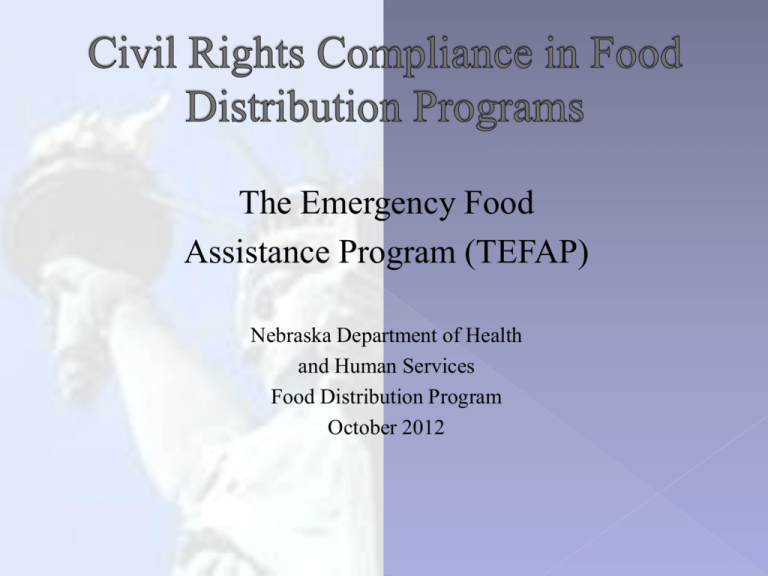
The Emergency Food Assistance Program (TEFAP) Nebraska Department of Health and Human Services Food Distribution Program October 2012 “The nonpolitical rights of a citizen; the rights of personal liberty guaranteed to U.S. citizens by the 13th and 14th Amendments to the U.S. Constitution and by acts of Congress.” The act of distinguishing one person or group of persons from others, either intentionally, by neglect, or by the effect of actions or lack of actions based on their protected classes. Any person or group of people who have characteristics for which discrimination is prohibited based on a law, regulation, or executive order. Protected classes in TEFAP are Race Color National origin Age Sex, and Disability. Federal financial assistance is anything of value received from the Federal government such as: Cash grants and loans, USDA food/commodities, Training, Property donations, Permission to use Federal property, and similar items and services. Title VI – Civil Rights Act of 1964 states: No person in the United States shall be discriminated against on the grounds of race, color, or national origin, be excluded from participation in, be denied the benefits of, or be subjected to discrimination under any program or activity. Example: Race/color: Treating or speaking to a child differently (using slang for example) or in a friendlier manner because of race or color. The Age Discrimination Act of 1975 provides: No person in the United States, shall, on the basis of age, be excluded from participation in, be denied the benefits of, or be subjected to discrimination under, any program or activity receiving Federal financial assistance. Title IX of the Education Amendments of 1972 states: No person in the United States shall, on the basis sex (gender), be excluded from the participation in, be denied the benefits of, or be subjected to discrimination under any educational program or activity receiving Federal financial assistance. Example: You shouldn’t offer smaller portions to women compared to men. The same size portion should be offered to each. Section 504 of the Rehabilitation Act of 1973 added disability to Title VI. Title II and Title III of the Americans with Disabilities Act of 1990 extended the requirements to all services, programs and activities of State and local governments and prohibits discrimination based on disability in other public services. USDA Regulation 7 CFR Part 16, Equal Opportunity for Religious Organizations: The purpose of this part is to set forth USDA policy regarding equal opportunity for religious organizations to participate in USDA assistance programs for which other private organizations are eligible. FNS Instruction 113-1: The purpose of this Instruction is to establish and convey policy and provide guidance and direction to the United States Department of Agriculture (USDA) Food and Nutrition Service (FNS) and its recipients and customers, and ensure compliance with and enforcement of the prohibition against discrimination in all FNS nutrition programs and activities, whether federally funded in whole or not. http://www.fns.usda.gov/cr/Documents/113-1.pdf Equal treatment for all eligible participants. Knowledge of rights and responsibilities. Overcome the Civil Rights barriers that people have in participating in a program. Dignity and respect for all. Local agencies are responsible for annual training. First line workers (including volunteers) and all levels of supervisors must receive required training. Training can be done in many ways. You are required to document your training efforts. At the end of the training, staff should: Be able to identify a civil rights complaint if received. Know what to do if they receive a complaint. Understand that it is the basic right of the individual to file a complaint. Name of the training Instructor. Date training was provided to staff. Topics covered in the training. Names of all the people attending the training. Use simple sign-in sheets which all participants sign at the end of the training session Keep your sign-in sheets in your files along with a copy of the training. Collection and use of data, Effective public notification systems, Complaint procedures, Compliance review techniques, Resolution of noncompliance, Reasonable accommodations for people with disabilities, Language assistance, Conflict resolution, and Customer service Currently participants self-declare the household’s information for TEFAP eligibility In general, any data collected about beneficiaries should be kept secure and confidential. May help to determine if more people could be reached in your community. May help to identify who needs to be reached yet. All FNS assistance programs must include a public notification system. The purpose of this system is to inform applicants, participants, and potentially eligible persons of: Program availability, Program rights and responsibilities, The policy of nondiscrimination, and The procedure for filing a complaint. Methods of Public Notification Prominently display the USDA nondiscrimination poster "And Justice for All,“ Inform potentially eligible persons, applicants, participants, and grassroots organizations of programs or changes in programs; including information pertaining to eligibility, benefits, and services, the location of local facilities or service delivery points, and hours of service. Provide appropriate information, including Web-based information, in alternative formats for persons with disabilities. Include the required nondiscrimination statement on all appropriate FNS and agency publications, Web sites, posters, and informational materials provided to the public. Let applicants and participants at your site know: their right to file a complaint, how to file a complaint, and the complaint procedures. Full Statement: “In accordance with Federal law and U.S. Department of Agriculture policy, this institution is prohibited from discriminating on the basis of race, color, national origin, sex, age, or disability. To file a complaint of discrimination, write USDA, Director, Office of Adjudication, 1400 Independence Avenue, SW, Washington, D.C. 20250-9410 or call ((866) 632-9992 (Voice). Individuals who are hearing impaired or have speech disabilities may contact USDA through the Federal Relay Service at (800) 877-8339; or (800) 845-6136 (Spanish). USDA is an equal opportunity provider and employer.” Minimum Statement: “This institution is an equal opportunity provider.” Include the non-discrimination statement on all materials that mention USDA programs; including websites, photos, and other graphics that are used in publications. Federal Relay Services www.gsa.gov/fedrelay Complaints may be based on: Race Color Age Sex Disability Complaints may be written or verbal. Complaints can be made via phone, letter, email, fax or any other form of communication. If receiving a verbal complaint, listen politely. May be anonymous Anonymous complaints should be handled as any other complaint May be related to any area of Food Distribution operations Program administration, food service, employment, etc. Never discourage groups or individuals from filing a complaint or from telling about a situation of potential discrimination Provide forms for written complaints Take detailed notes of complaints. If the complaint is made via phone call or the person wishes not to put the complaint in writing, the staff person will need to write up the details of the complaint to be submitted. Information Needed: Who is complaining Name Address Telephone number Where it happened What agency What address What happened Basis for the claim Race Age Disability, etc. Name of anyone who saw or heard what happened When it happened Date Time Send the complaint letter to: USDA Director, Office of Adjudication 1400 Independence Avenue, SW Washington, DC 20250-9410 And the Nebraska Food Distribution Program office: Nebraska Food Distribution Program Attn: Civil Rights Complaint 301 Centennial Mall South Lincoln, NE 68506 Civil Rights Complaints Form basic components Full name of person filing complaint: Address of person filing complaint: First Middle Street / P.O. Box City State Daytime phone number of person filing complaint: ( ) Name and location of the agency / entity delivering the service or benefit: Last Zip Describe the nature of the incident or action that led to the complaint or provide an example of the method of administration which is having a disparate effect on the public, potential participants, or participant On what basis does the complainant feel discrimination exist? (race, color, national origin, sex, age, or disability): Provide the name(s), title(s) and business address(es) of persons who may have knowledge of the discriminatory action: Indicate the date(s) during which the alleged discriminatory actions occurred, or if continuing, the duration of such actions: Name of person completing the report Title of person completing the report Date The purpose is to determine if the applicant or recipient of Federal financial assistance is in compliance with civil rights requirements. Reviews can be completed: Pre-award, Post-award, and Special Local Agency Civil Rights compliance is reviewed during a management evaluation. Display of non-discrimination poster in conspicuous location. Non-discrimination statement on all printed materials and web sites. Local Agency provides outreach materials to organizations within the community to reach all eligible populations. Annual civil rights training conducted for staff. Procedure in place to handle civil rights complaints in accordance with regulations. Corrective Action Plans (CAP): Should outline the action that will be taken to correct any findings, the timeframe in which the action will be taken, and how any noncompliance issues will be prevented in the future. Should be submitted to the State within 60 days of receipt of findings. Failure or refusal to implement a Corrective Action Plan may result in loss of Federal Assistance. Ensure that people with disabilities can get into your agency from the parking lot, entrances, hall, elevators, rest rooms, as well as allowing service animals Arrange ways for people to get services Example: If your program is in the basement and you don’t have an elevator, staff should be available on the main floor. FedRelay Telecommunications services to allow individuals who are deaf, hard of hearing, and/or have speech disabilities. www.gsa.gov/fedrelay Definition: Individuals who do not speak English as their primary language and have a limited ability to read, speak, write, or understand English. All organizations receiving Federal Financial Assistance have a responsibility to take reasonable steps to ensure “meaningful” access to their programs and activities by persons with LEP. The number or proportion of LEP persons eligible to be served or likely to be encountered by the program or grantee; The frequency with which LEP individuals come in contact with the program; The nature and importance of the program, activity, or service provided by the program to people’s lives; and The resources available to the grantee/recipient and costs. A shortage of resources does not eliminate the requirement of “Reasonable Steps”. Potential Cost Reduction Solutions: Using technological advances; Sharing of language assistance materials and services among and between recipients, advocacy groups, and Federal grant agencies; Where appropriate, training bilingual staff to act as interpreters and translators, telephonic and video conferencing interpretation services, or the formalized use of qualified community volunteers. Pooling resources, and Standardizing documents to reduce translation needs Children who are minors should not be used as interpreters. Volunteers may be used, but make sure they understand confidentiality! Prototype applications in other languages: http://www.fns.usda.gov/cnd/FRP/frp.process.ht m See www.lep.gov for more information How is your Attitude? Always clearly introduce yourself when answering the telephone and do not interrupt the caller. Be patient. Give the customer every opportunity to explain the issue. Be understanding. Of all the communications situations that you encounter, angry customers require the most empathy. Do not be judgmental. Talk calmly and slowly; in a well modulated voice (low pitch). This should help relax the person and allow you to address the facts, not cater to emotions. Be sincere. Even if you sense that the problem is not the fault of your organization and clearly not your fault, it is ok to apologize to the customer for his or her inconvenience; not necessarily the actions by your agency. Be aware. Get help if threatened or if violence is possible. What Steps do you need to take? Remain calm What is the problem? Using information provided, determine what the issue is. Determine a solution. Know your organization’s policy on handing situations and information needed to offer a solution. Gain approval from the Customer. Check with the customer for their approval on a solution. Make an agreement. You and the customer should determine what is to be done, when it is to be done, and by whom and alternatives if needed. Follow up. Personally make sure that the customer has been satisfied; and provide feedback. Making a Difference Treat all people with dignity and respect. Answer questions in a voice that is nonthreatening . Clearly explain to everyone the rules as well as their rights and responsibilities. Find and use tools and techniques to improve customer service. Recognize when stress creates a problem in giving service excellence. Making a Difference Recognize that participants have varied needs and (sometimes) few resources. Notice when a person feels they have been treated in a rude manner. Develop good listening skills. Learn to put yourself in their place when necessary. Learn to deal with dissatisfied customers. Improve customer satisfaction. Cover the basics Give people an understanding about how the civil rights got started (i.e. laws that cover all federally funded entities) Use examples Expect issues and questions and be prepared to address them Recognize and value differences Be sensitive, civil rights can be very personal and people approach it from different angles. Answer questions directly and clearly. If you don’t know the answer DO NOT make something up – agree to get the answer and then follow up. Contact Nebraska Department of Health and Human Services Food Distribution Program for assistance. www.fns.usda.gov/cr/ www.ascr.usda.gov/ www.ascr.usda.gov/complaint_filing_cust.h tml#processing www.fns.usda.gov/cr/Documents/113-1.pdf www.lep.gov www.fns.usda.gov/cnd/FRP/frp.process.htm Training created by Nebraska Food Distribution Program, October 2012.
